chapter
Forms of Hybridity
00:04 And we’re back for the final chapter, which is about forms of hybridity. Again, we had a change of hosts. I’m Senka and I’m hosting this chapter together with Jordi. We’re joined by Michael Murtaugh, who is the course leader of the Experimental Publishing MA program (XPUB) at the Piet Zwart Institute. Read more about the XPUB program here: https://xpub.nl As a practitioner, he designs and researches websitecommunity databases, videointeractive documentaries, and tools for textnew forms of reading and writing online. Besides Michael, we are also joined by Sepp Eckenhaussen, who is a researcher at the Institute of Network Cultures (INC) and has been the leader of the Hybrid Publications group of Going Hybrid. Other members of this group were Ashley Maum and Ebissé Wakjira on behalf of Framer Framed, Ania Molenda, Anna Maria Michael, Carolina Pinto, Gijs de Heij, Maria van der Togt, Ray Dolitsay, Tommaso Campagna, and Victor Chaix. Welcome!

Jordi Viader Guerrero, Michael Murtaugh, mushy, Senka Milutinović, and Sepp Eckenhaussen discuss forms of hybridity in cultural programs.
01:07 What is the red thread in this conversation? There are many points of connection. Both Michael’s and Sepp’s groups work with the ‘afterlife of liveness’. Thinking about how the public engages with (post-)live content of, for instance, performancecultural events and audioradio programs, both groups have asked: How to create an afterlife of liveness that also engages with collective practices of sense-making? In their experiments, both groups engaged with different forms and mediums within hybridity, seeking out different narrative structures and forms of non-linearity. Moreover, they’ve experimented with the form of databases, repositories, and protocols. For this work, both groups try to make use of existing open-source tools, such as etherpads and wikis. They also think about hybridity as a way to create publics through the use of different interactions it enables. So hybridity is a way of making things public, but also a way of creating publics. These many points of connection lead me to my first question.
Old and New Forms of Hybridity
02:01 To both of you, Michael and Sepp: What do you think or what do you find to be that tested and tried, old ways of hybridity in contrast to the newer, and more groundbreaking ones? This question was inspired by Andrej Kapor, ‘IHWAT 2022 The Event: Wine Flows and Other Things’, Institute of Network Cultures, 20 June 2023, https://networkcultures.org/goinghybrid/2023/06/20/ihwat-2022-the-event-wine-flows-and-other-things. In this blogpost, Andrej refers to hybrid connections as a combination of groundbreakibly new and traditional and tested ways. 🪦
[00:02:23] Thanks. Nice question. Big one, too. I’ll just take it from the angle of our research group, which has been focusing on hybrid publications. In the case of hybrid culture, of course, that very easily becomes the hybrid event report. So what is indeed the afterlife of the hybrid cultural event in a hybrid setting?
02:43 The idea of a ‘hybrid publication’ has been around for a long time. It usually is taken to mean a textbook that's available in both print and in websitedigital format. To explain that a bit better, I’ve brought a book. I don’t know if people can actually see it because it’s green, but it’s called From Print to E-books. From Print to E-books: A Hybrid Publishing Toolkit for the Arts (Amsterdam: Institute of Network Cultures, 2015), https://networkcultures.org/wp-content/uploads/2014/12/0419-HVA_DPT_from_print_to_ebooks_OS_RGB_aanp_lr_totaal.pdf. This book is the result of a previous INC research project, about ten years ago, in which Michael was also involved. The research blog of this research project, called Digital Publishing Toolkit, is available on the website of the INC: https://networkcultures.org/wp-content/uploads/2014/12/0419-HVA_DPT_from_print_to_ebooks_OS_RGB_aanp_lr_totaal.pdf. It’s a workflow for making a print book that’s also available in two digital versions, ePub and PDF. I would say this is the old and tested and also proven form of hybridity in publication making. Since 2015, the Institute of Network Cultures has published over 50 books using this workflow, most notably the Theory on Demand series: https://networkcultures.org/publications/#tod. It is now adopted by the mainstream publishing industry as well.
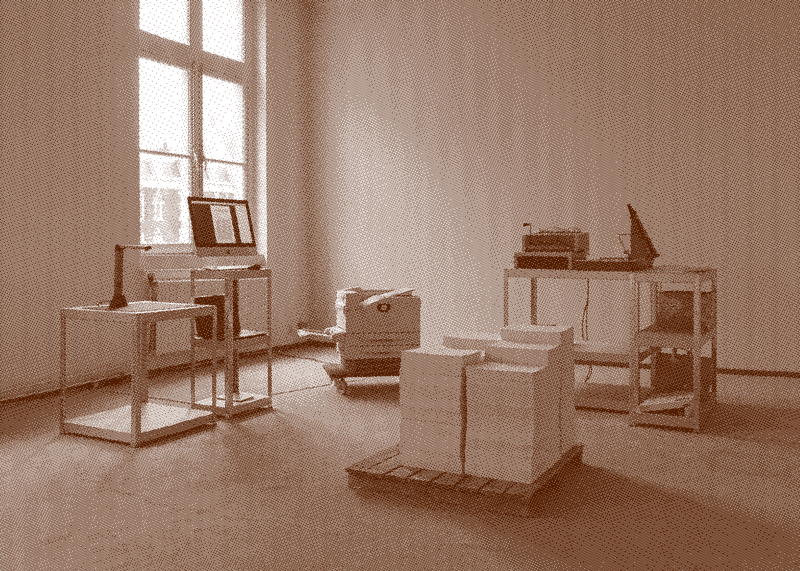
Maria van der Togt, Hard Copy Soft Copy. Installation view from 2021.
03:40 Now, within the context of Going Hybrid, we’ve been looking at expanding or exploding the old methods of hybrid publishing into different media, into audioaudio, into spaceonsite interventions. green book gets keyed We had multiple people in our group that were doing experiments like this. For instance, Maria van der Togt created the work Hard Copy, Soft Copy: a websitelittle local server hosting a ton of pirated textbooks, combined with an objectonsite book printing station. Read more about Hard Copy Soft Copy here: https://sandberg.nl/alumni/maria-van-der-togt/work/hard-copy-soft-copy–impermeable-domains. Another example is Victor Chaix, who developed the concept of digital social text. Victor Chaix, ‘Hypothes.is: Playing with Digital Texts’ Expandable Confines’, Institute of Network Cultures, 2023, https://networkcultures.org/longform/2023/07/13/hypothes-is-a-story-of-playing-with-digital-texts-expandable-confines. He’s looking at the afterlives of online text and how people can create social relationships and meaningful conversations with each other using tools like the websitebrowser plug-in Hypothes.is. Hypothes.is is a browser plug-in that allows the user to (collaboratively) annotate any website. Read more: https://web.hypothes.is. These are different forms of hybridity that we try to explore in different directions from this point. Read more about the Hybrid Publishing group and the backgrounds of the members here: https://networkcultures.org/goinghybrid/2022/07/06/the-crowbar-of-cultural-publishing-introducing-the-hybrid-publications-research-group.
04:47 If you’ll permit, I’m going to respond with an anecdote. Last Wednesday, while I was preparing for this conversation, I heard a audiobeeping noise. It was one of these notification that you don’t know where it comes from. So I ignored it, but it and kept beeping. Finally, I switched back to my computer’s Terminal, which I had open and I was logged in to a server at the school and I saw on my screen:
Broadcast message from zerozeta@chopchop (pts/1) (Wed Nov 8 11:02:27 2023): XPUB is a two year masters program. XPUB focuses on the acts of making things public and creating publics in the age of post-digital networks. XPUB is a good idea, until now. XPUB education is a good idea, but was it enough?
Broadcast message from vitrinekast@chopchop (pts/2) (Wed Nov 8 11:03:49 2023): XPUB is a master program dedicated towards the research of new and old technologies, and their social impact and how we relate to these changes. When the apocalypse happend, many of the larger institutions shut down, and people were left to fend for themselves, in the physical and virtual realm. So, indeed, and XPUB education is a good idea, but was it enough?
Broadcast message from aleevadh@chopchop (pts/3) (Wed Nov 8 11:06:22 2023): It is a safe zone, a bubble, a place for starved, lost, creative minds. XPUB is experimentation! It is being confused but still going. It may be a crash course on how to survive the apocalypse that will soon hit us, but I will learn more about that later.
06:25 I like reading this message out loud now, because it creates a bridge with videoAymeric and Clara's contribution to this publication, which considers this idea of XPUB as a doomsday prepper program. For Screentime Airtime Facetime, Clara Balaguer and Aymeric Mansoux co-authored ‘Intermission 1: Can You Hear Me?’ (For the Record). I think they’re right, in the sense that XPUB really challenges students to think about this question of old versus new. We especially question the idea that equates newer to better. Instead, we try to capture new, different values by working with older technologies.
07:05 This is a bit farfetched, but these beeping sounds were actually the result of a command called ‘wall’ that allows people who share a server to send textmessages to other people who are logged in to the same server. wall, which stands for ‘write to all’, is a Linux command-line utility that displays a message on the terminals of all logged-in users It comes from the 1960s when computing was something very scarce and extremely expensive. As a result of that reality, you needed to create an operating system to make it shareable. It had a sociality embedded in it. By looking at these older forms, we open up new questions around the values embedded in the technology. What kind of choices can we still make?
Linearity, Non-linearity, Multi-linearity
08:03 Besides focusing on the dichotomy of old versus new, to ask a direct question to Sepp: since you’ve worked a lot on this event reporting tool, you’ve closely looked at the structure that event reporting can take. I want to ask you about the forms of linearity or non-linearity you encountered. How can they assist cultural institutions as narrative forms?
08:46 This question has two major dimensions. On the one hand, it’s a bigger question of reading cultures, practices, and values. On the other hand, we can make the question very practical. Let’s face it: most cultural event reports are just really boring. They usually go like: this happened and then that happened and then that happened. No one wants to read that. In the end, this practical question is one of access. How to open up different pathways that are more interesting for people to engage with content in a more meaningful way? Based on the combination of these questions, we started to rethink the cultural event report in a nonlinear or multi-linear way.

A spread from the minizine Elements of the Conversation Starter.
09:31 Our initial approach was more editorial than tech-oriented. On one of the first days we worked together, we made a little objectminizine called text'Elements of the Conversation Starter'. We did that during one day together at Varia in Rotterdam and then risoprinted it on the spot - it was really fun! You can download or read the minizine here: https://networkcultures.org/goinghybrid/2022/11/14/minizine-elements-of-the-conversation-starter. In this minizine, we map out what we find to be meaningful types of take-aways from cultural events. One element is mood or atmosphere. For instance, if spaceit's snowing outside during an event, a reporter might not think about including that in the report, but it’s actually interesting to read because it sets the stage, and sketches a mood. Then, there are also more traditional elements, like interesting quotes, and the red thread of an event. Having defined these types of main take-aways that can make event reports interesting, we started mapping or tagging this kind of content to see what kind of different pathways start emerging from a text.
10:29 Non-linear storytelling has a very long and rich history, especially in game design. For a good overview, see Marc de Bruijn, ‘Non-linear Publication Tools’, Institute of Network Cultures, 2018, https://networkcultures.org/makingpublic/2018/12/13/non-linear-publication-tools. So, once the work became more technical, we could work with many existing tools. You can find an overview of the tools and practices that inspired us on the research blog: https://networkcultures.org/goinghybrid/2022/10/03/relevant-tools-practices-in-hybrid-publishing. We tried working with Twine, which we found very interesting. A previous research program headed by the INC had already explored the possibilities of non-linear stand-alone publishing. The resulting manual Inside Out Upside Down: Discover the Hidden Structures of Your (Digital) Content suggested Twine as an interesting tool. See: https://networkcultures.org/makingpublic/wp-content/uploads/sites/45/2020/03/Upside-Down-Inside-Out-Manual.pdf. In Twine, you can create different types of blocks of texttext that can then link to each other in different ways to create a weblike structure. But after a while, we found that the backend of Twine turned out to be more interesting than what we could make with it on the front end. In the end, we ended up working with a simple tagging system, and integrated this in the final prototype of Etherport. Etherport and its functionalities are introduced in ‘Intermission 3: Introducing Etherport’.
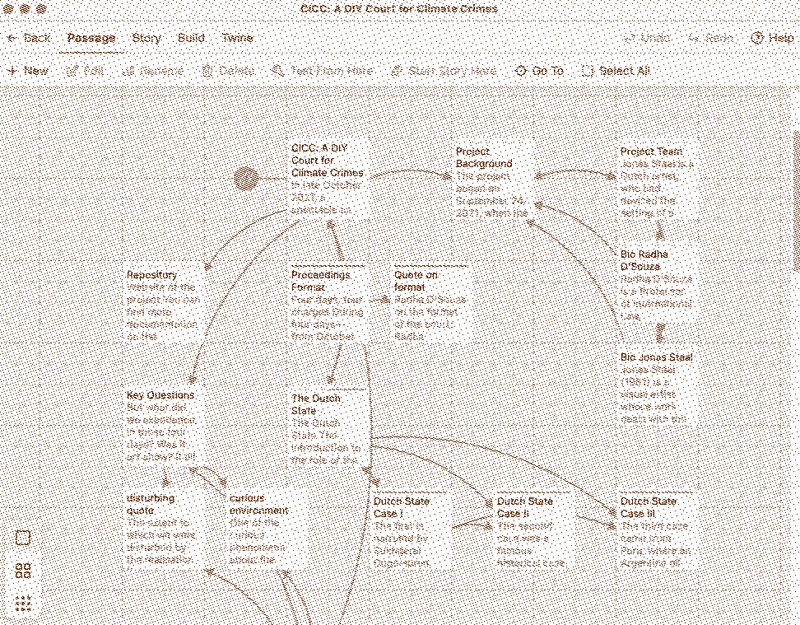
The backend view of a non-linear cultural event report in Twine, created by Ashley Maum in the Hybrid Pubs group.
11:15 To come back to the larger question of reading culture, the promise behind Etherport is not just one of a shared infrastructure between different cultural institutions. What Victor Chaix tries to define with this concept of text'digital social text' is a new reading culture. A culture in which the reader has more agency, and can start interacting with and ideally adding to the text while engaging in conversation with other readers. As a consequence, this ideal type of new event report is more of a ‘conversation starter’ that couldn’t be contained linearly even if you wanted to. check out the minizine here: https://networkcultures.org/goinghybrid/2022/11/14/minizine-elements-of-the-conversation-starter
11:52 Thank you!
Experimenting with Protocols
11:56 Sepp is talking about our new reading culture. I think it’s a very interesting concept, which implies new protocols too: a structured way to read, share, and understand each other. thanks for the link runs! But there might also be a tension between experiments and protocolization. Michael, do you have reflections or thought about that tension? Looking at all of the work you’ve done with XPUB masters program, how can we understand the protocol beyond a firm set of rules that constrains us?
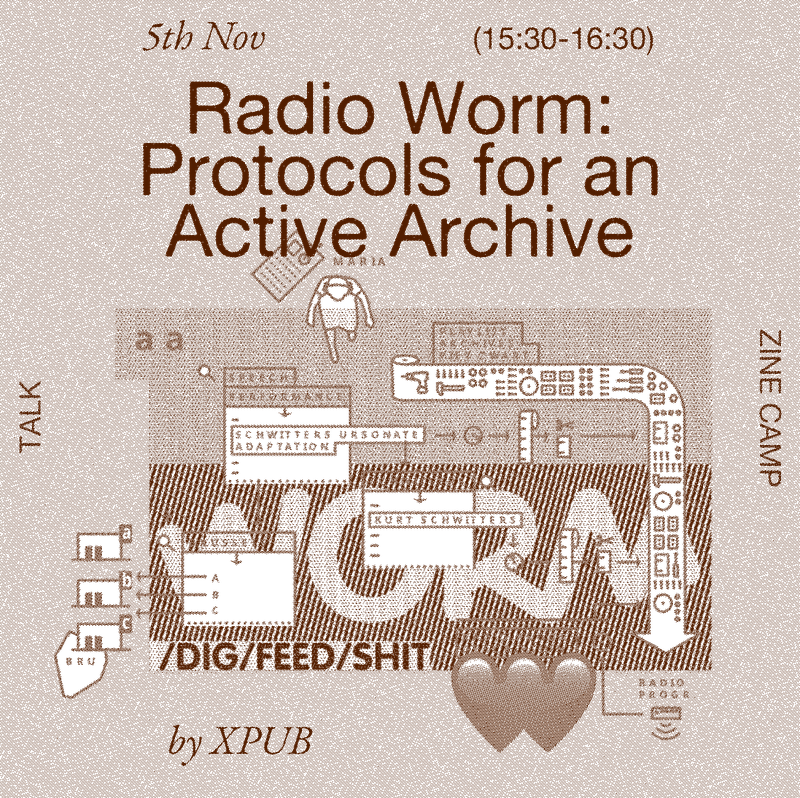
Announcement of the XPUB radio show at the Zinecamp 2023 in Worm, Rotterdam.
12:42 I’ll start by giving some context. Since September 2023, XPUB has taken part in Going Hybrid, so we came a bit late into the process. Going Hybrid started in January 2022. Since then, we have been running audioa weekly radio program at Radio Worm, which is an online radio stream. Each week, Tuesdays from 10 to 12, we’re producing a radio program ‘Protocols for an Active Archive’. A texttranscribed excerpt of that program is included in this book as one of the intermissions. In that snippet, Leslie, our course coordinator, describes pushing back on protocols. performanceIt's a very personal story of a friend who resists the conformity imposed by an outdated dress code.
13:40 Protocols define conformity. But in social situations without a protocol, something emerges that Jo Freeman has famously called ‘the tyranny of structurelessness’. https://radio.worm.org Jo Freedman, ‘The Tyranny of Structurelessness’, 1970, https://www.jofreeman.com/joreen/tyranny.htm. The problem is that without a protocol in social situations, you often fall back into established, implicit power relations. So having explicit protocols is quite important. more info on this kind of new reading culture here: https://networkcultures.org/longform/2023/07/13/hypothes-is-a-story-of-playing-with-digital-texts-expandable-confines
14:08 An important text that we read in the XPUB program is textSimon Yuill's 'All Problems of Notation Will Be Solved by the Masses'. Simon Yuill, ‘All Problems of Notation Will Be Solved by the Masses’, Mute, 23 May 2008, https://www.metamute.org/editorial/articles/all-problems-notation-will-be-solved-masses. In it, Yuill described how musicians in the sixties and seventies devised various forms of protocols, as well as different systems of textnotation, to break out of the esthetic and social conventions. Think of examples like audioCornelius Cardew and the Scratch Orchestra. student-at-the-back is brought to the front without anticipation I feel disturbed in my distanced identity For example: https://www.youtube.com/watch?v=AnN5bAkd6jw&ab_channel=INVIGORATION. These protocols would often have the form of games that played around with leadership roles. The point is that, just like a children’s game of tag, you’re playing out different possibilities and it’s disrupting the established order. There is not some informal, implicit leader, but by defining a protocol together, these people speak about who’s the leader now, and how and why to give the leadership over to someone else. /camera:75 performanceAfter this conversation, performers are more 'awake' and responsive to each other. I think it’s really exciting. /camera:70
15:36 From this text, we draw links to educational coding projects like Logo; or contemporary coding practices like free software, hackerspaces, and live coding. Yuill writes:
16:14 This is the context in which we’ve worked with Radio Worm. Worm is a Rotterdam-based alternative community radio broadcast station. See and listen here: https://radio.worm.org. It’s been a privilege, because whether it’s an old form or a new form (probably both), radio gives an incredible amount of freedom. Ash Kilmartin, who works at Radio Worm and is a prolific radio maker, gave an interesting example of protocols for radio. She has developed what she calls the ‘back-to-back’ protocol for the radio program ‘Ever Widening Circles’ which she makes with a partner. Listen back to Ever Widening Circles on Mixcloud: https://www.mixcloud.com/EverWideningCircles/stream. It involves preparing a base of music, but then coming together and sitting and engaging in a game of playing things from the prepared playlist in an unannaounced order. Then, the other person, on the fly, tries to respond with what they play in return. It’s a really nice example of how to embrace the excitement of liveness in a playful protocol. The listener hears directly what is being done by the producers. /camera:75
18:04 It’s interesting. I think a lesson is that protocols can be empowering as well. good to be challenged student in the front They can create possibilities for people to act in a way that they couldn’t without having protocols. Protocols can empower a new type of culture. By that, I don’t mean that protocols replace new culture. The idea that protocols can replace culture or meaningful interactions between people is a common misunderstanding encountered, for instance, in the discourse around blockchain. This is nonsense. On the contrary, we can use the protocol as a basis to start inventing new types of relationships. I feel like that’s what is happening in the experiments described by Michael.
18:51 In the Hybrid Publications group, we worked with the definition of hybrid as a new combination of existing formats. This implies new protocols insofar as hybrid cultures combine existing forms, tools, and formats into new workflows, that in turn create new approaches to cultural production. We found it important that these new protocols don’t dictate practice too much, but instead create space for the good old and tested craftspersonship of, for instance, the event reporter. The method used by the Hybrid Pubs group was workflow-first design. They mapped out the entire workflow of event reporting. Sepp Eckenhaussen, ‘Workflow Improvements for Hybrid Event Reports’, Institute of Network Cultures, 12 October 2022, https://networkcultures.org/goinghybrid/2022/10/12/workflow-improvements-for-hybrid-event-reports.
19:28 This very live-publication is a good example. There is a websitechat room in the live stream, where live annotating takes place as we speak. The livestream platform of The Hmm, which was used for this live-publication event, often hosts a lively chat. The texttext from this chat will literally be the annotation of the book that will be produced after this event. I can share the protocol that was developed for this purpose. A group of five people are dedicated reporters in that chat, and they’ve all assumed different roles. !!! They are doing a roleplay together that enables them to comment on this event in their specific way. It creates a new, alternative linearity within the publication. The chat conversation can take different turns and then come back to what we were talking about now. For instance, about half an hour ago, the people in the conversation-chapter were talking about game design while the chat was going on about #hopecore. This freedom to diverge and later converge again is the result of the reporting protocol that we’ve created together. #craftpersonship
20:34 I would like to follow up on this idea of the hybrid as a new combination of existing formats. XPUB students have been working with the very old medium of radio. But I know that they’ve also been thinking about new ways to activate the public, to make radio less of a one-directional medium. 🫂 Michael, can you comment on that and give insight into what they were experimenting with? 🦄 shoutout to the chat
21:03 We were working with a lot of older media, like cassette radio players, and detourning them. We also explored how technology, especially new, so-called ‘cutting-edge’ technology, tends to be extremely prescriptive, which limits its use. The term ‘prescriptive technology’ was coined by Ursula Franklin in The Real World of Technology (1992), https://archive.org/details/the-real-world-of-technology. Prescriptive technologies organize work as a series of steps that require the supervision of a boss or manager, and are opposite from holistic technoloqies, which allow the worker to have oversight over the entire production process. The effort to circumvent this prescriptive, one-directional technology can, again, be explained in terms of social protocols.
21:27 Each Tuesday, we would have an interview. textWe had an Etherpad, where we would write some possible as we started to think, and in the process, we would allow our focus to shift. Etherpad is an open-source web tool for collaborative writing. I think this resonates with the earlier discussion about the archive. Michael refers to Chapter 1 Radio Worm’s archive shouldn’t be just about collecting all the audioMP3s and dumping them somewhere, as, by the way, they’re already doing on websiteMixcloud. Maybe we should focus more on the community, on how this radio is made, and who the makers are. And so we’ve shifted to interviewing the makers. Tuesday morning we started for the first time at the studio with no set ‘caretakers’, as we call them (in the past we had prearranged a caretaker role). ‘Caretakers’ are the students in the radio studio during the broadcast, who take care of that weeks radio show plan. We started by playing a recording of something we presented on Sunday at the spaceZine Camp in Worm. To find more about Zine Camp 2023 check: https://zinecamp2023.hotglue.me/?home. While that was happening, the class was voting on questions to ask the makers. Then, performancewe had a rotating shift, of different question askers and engineers to do the mixing. unfortunately we need to keep a low volume here :( Ash, Lucas Simonis, and Lieuwe Zelle, the main makers of Radio Worm, got asked these questions. It was in the space of 48 hours, so much had been happening. We were textconnected on the pad but also spacevisible through the studio window. I think that was an amazing experience.
23:02 I’d like to bring up another experiment that XPUB students have done. In the choose-your-own-adventure game audioradio broadcast, the audience could textwrite in an Etherpad and guide the people who are audioon the radio where they’re going next, and which part of a narrative they’re performancepresenting. This game was based on David Maroto’s research into the ‘Choose Your Own Adventure’ gamebook, which was very popular in the 1990s, just before the advent of the internet. See: https://www.davidmaroto.info/The-Wheel-of-Fortune. Radio was no longer one-directional, but the audience had agency and even guided the people who were supposed to be the presenters. They were changing the medium and allowing it to be more than what it was conceived to be. The choose-your-own-adventure radio broadcast was called ‘The Hitchhiker’s Guide to an Active Archive’
23:46 Absolutely! That was a great experiment.
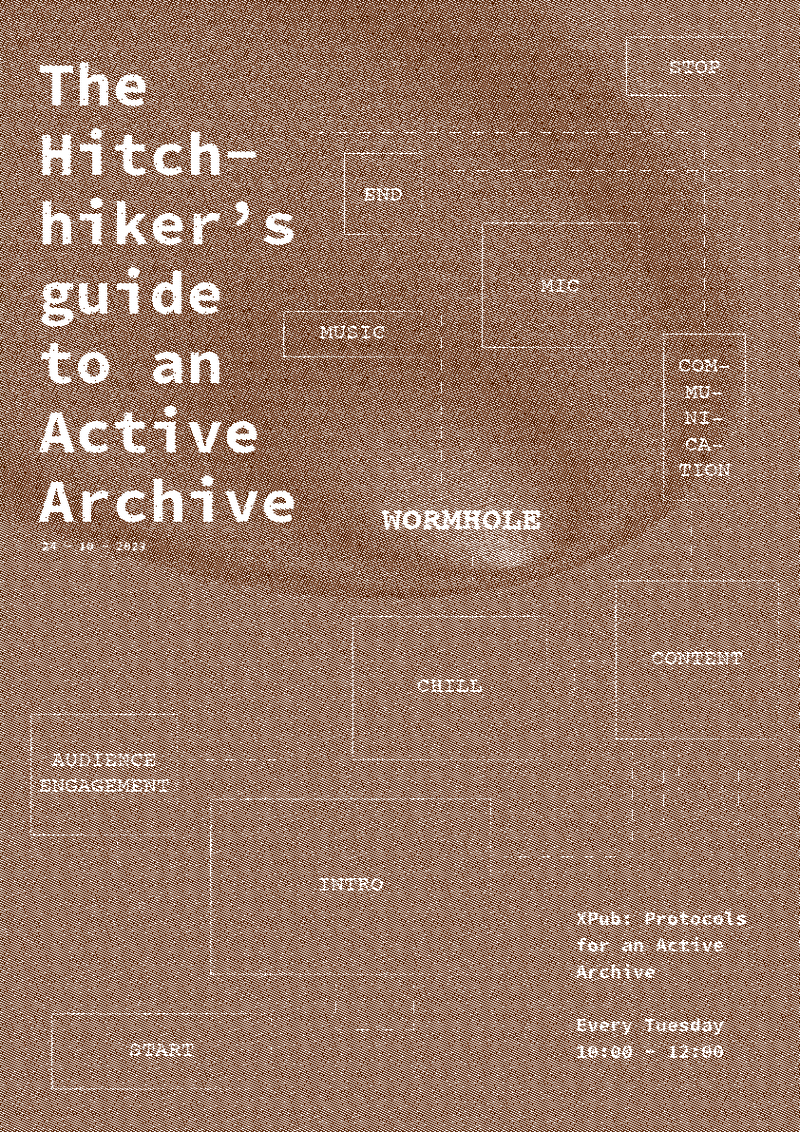
Announcement image for the choose-your-own-adventure broadcast ‘The Hitchhiker’s Guide to an Active Archive’, organized by XPUB students.
The Fediverse
23:52 I would like to go back to the ideas of the afterlife, the apocalypse, and the prepper mentality that Michael mentioned earlier, and connect them to our relationship with institutions. These doomy concepts are attractive at least partly because of a lack of trust in institutions. People don’t want to be dependent on certain institutions. Is the afterlife or catastrophe an attitude towards protocols?
24:43 For me, this evil institution is not the museum around the corner. The institutions we should fight are Meta and all the other Silicon Valley monopolists. whisper (?) to the chat? They create platform homogeneity and dependency. They exhausting both planet Earth and our collective mental energy just to of maximize their profits. This is the material reality in which we have to position our social protocols. In that regard, I think we need a Fediverse: a cultural publishing infrastructure that we build with and share among our allies. we have to These may include cultural institutions, workers, and collectives. A great example such a decentralized infrastructure is in the cultural field is Biblio-Graph, a decentralised archiving tool developed by Archival Consciousness. This tool can pool data from different organisations and provide really interesting non-linear explorative experiences to the people that use it. In project The New Social, which was aligned to Going Hybrid, Archival Consciousness developed a publishing tool for catalogues on top of Biblio Graph. Visit Biblio-Graph here: https://biblio-graph.org/public. I think would be valuable to explore this further in the future. c: How can we, as counter-hegemonic cultural actors, not sit on our own island and develop our own little tools Yess seppi (which is super exciting and usually based on the same kind of base framework of open source software), but band together and exchange our practices according to the social protocols that we define? what is this fettiverse Seppi mentioned?
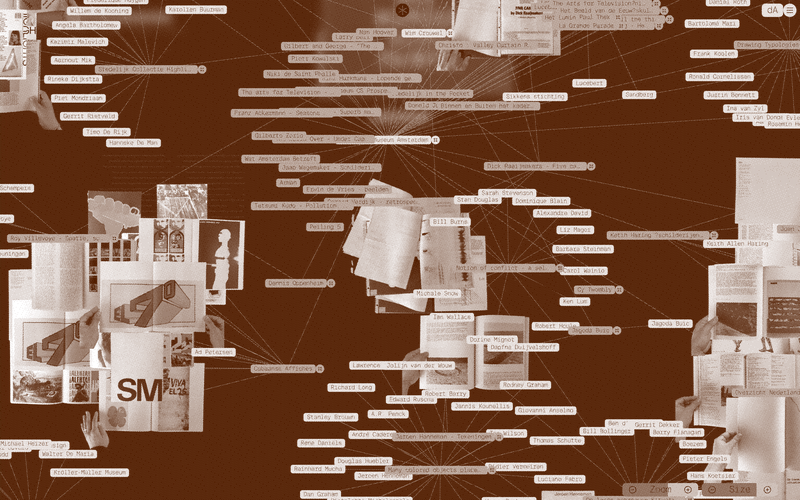
Screenshot of the Biblio-Graph networked archive.
26:04 I would also like to connect back to Clara’s intermission. does anyone have questions for the live hosts? feettiverse ? 👀 Clara mentioned how people in the Philippines were ready for catastrophe implicitly, because they those institutions or industries haven’t traditionally been there for them. As a result, the Philippines is a society that’s much more prepared to work locally and to care about the community. Another inspiration is, again, audioRadio Worm. They don't broadcast on FM, because they don’t need to have a huge audience. They work much more in a tradition of audioavant-garde music, where people were working in small-scale, connected alternative scenes. My point is: we’re not trying to recreate Meta. It’s about creating counterpoints by cultivating spacenonstandard spaces that can function differently. The Fediverse can bring mass to these counterpoints, so that networked initiatives can nourish each other, rather than then having to always fend for themselves and eventually disappearing.
27:19 Keywords in this are ‘platform alternative’ and ‘counter-tradition’, right?
27:30 We should connect these to past experiences. It’s not the first time someone has tried this. These alternatives have existed for ages in different forms.
27:50 Are there any audience questions from the chat that we can address?
28:02 There’s one question: what is this Fediverse?
28:13 It’s the idea that we have a federated digital infrastructure. This is, by the way, not something so radical or new. In fact, email is federated. But big up to these words, I feel like this section really grounds the purpose of this whole hybrid event … which is developing social and network protocols and non standard medium combinations and spaces that battle the platform homogenization (the mid) There’s no technical need for a centralized company like Google to provide you with email services. Instead, we have a shared resource, an inter-network of networks. Everyone can have their own inbox, with different providers, but still connect to each other. spaceIn the Fediverse, this kind of federated software is cultivated. For instance, Mastodon is an alternative to Twitter. There is not one centralized Mastodon server, but anyone with the required skills, time, and resources can run a Mastodon server. It looks like Twitter and it functions almost the same as Twitter, but it can be managed at a community level. How to arrange moderation? Which other instances do you as an institution want to follow or not follow? This is a subtle shift away from individual settings and responsibilities, to allowing more local institutions to be able to make decisions and take care of infrastructure together. But it works globally over the Internet as a protocol.
29:46 Great. Thank you, Michael and Sepp. federation ≠ centralization ≠ decentralization
About this Text
Senka Milutinović is a researcher, writer, and multimedia designer. They are a research tutor at Willem de Kooning Academy and are a co-editor of Screentime Airtime Facetime.
Jordi Viader Guerrero (MX/ES) is a practice-based researcher in philosophy of technology and media, currently doing a PhD at TU Delft on the reimagining of algorithmic practices for democratic engagement. His research and practice are chiefly focused on using design and theory to articulate digital technologies within wider cultural, political, and epistemic logics.
Michael Murtaugh is the course leader of the Experimental Publishing MA program (XPUB) at the Piet Zwart Institute.
Sepp Eckenhaussen is a researcher at the Institute of Network Cultures (INC). He was the leader of the Hybrid Publications group of Going Hybrid, and co-edited Screentime Airtime Facetime.
This chapter-conversation was originally recorded during the a live event Screentime Airtime Facetime, which you can watch back here: https://vimeo.com/908215511.